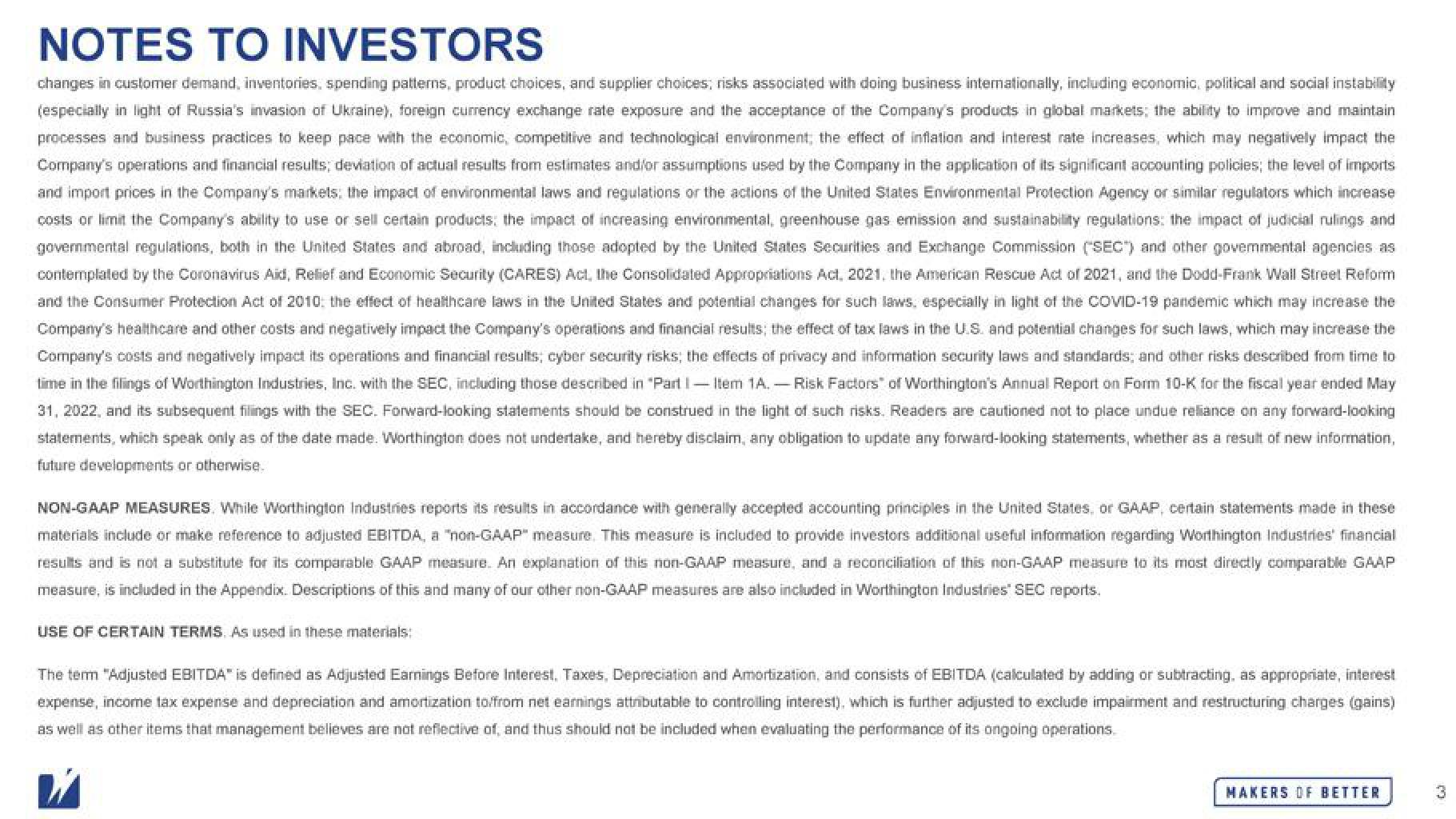Worthington Industries Mergers and Acquisitions Presentation Deck
NOTES TO INVESTORS
changes in customer demand, inventories, spending patterns, product choices, and supplier choices, risks associated with doing business internationally, including economic, political and social instability
(especially in light of Russia's invasion of Ukraine), foreign currency exchange rate exposure and the acceptance of the Company's products in global markets; the ability to improve and maintain
processes and business practices to keep pace with the economic, competitive and technological environment, the effect of inflation and interest rate increases, which may negatively impact the
Company's operations and financial results; deviation of actual results from estimates and/or assumptions used by the Company in the application of its significant accounting policies; the level of imports
and import prices in the Company's markets, the impact of environmental laws and regulations or the actions of the United States Environmental Protection Agency or similar regulators which increase
costs or limit the Company's ability to use or sell certain products, the impact of increasing environmental, greenhouse gas emission and sustainability regulations: the impact of judicial rulings and
governmental regulations, both in the United States and abroad, including those adopted by the United States Securities and Exchange Commission (SEC) and other govemmental agencies as
contemplated by the Coronavirus Aid, Relief and Economic Security (CARES) Act, the Consolidated Appropriations Act, 2021, the American Rescue Act of 2021, and the Dodd-Frank Wall Street Reform
and the Consumer Protection Act of 2010: the effect of healthcare laws in the United States and potential changes for such laws, especially in light of the COVID-19 pandemic which may increase the
Company's healthcare and other costs and negatively impact the Company's operations and financial results; the effect of tax laws in the U.S. and potential changes for such laws, which may increase the
Company's costs and negatively impact its operations and financial results, cyber security risks; the effects of privacy and information security laws and standards, and other risks described from time to
time in the filings of Worthington Industries, Inc. with the SEC, including those described in "Part I-Item 1A.-Risk Factors" of Worthington's Annual Report on Form 10-K for the fiscal year ended May
31, 2022, and its subsequent filings with the SEC. Forward-looking statements should be construed in the light of such risks. Readers are cautioned not to place undue reliance on any forward-looking
statements, which speak only as of the date made. Worthington does not undertake, and hereby disclaim, any obligation to update any forward-looking statements, whether as a result of new information,
future developments or otherwise.
NON-GAAP MEASURES. While Worthington Industries reports its results in accordance with generally accepted accounting principles in the United States, or GAAP, certain statements made in these
materials include or make reference to adjusted EBITDA, a "non-GAAP" measure. This measure is included to provide investors additional useful information regarding Worthington Industries financial
results and is not a substitute for its comparable GAAP measure. An explanation of this non-GAAP measure, and a reconciliation of this non-GAAP measure to its most directly comparable GAAP
measure, is included in the Appendix. Descriptions of this and many of our other non-GAAP measures are also included in Worthington Industries' SEC reports.
USE OF CERTAIN TERMS. As used in these materials:
The term "Adjusted EBITDA" is defined as Adjusted Earnings Before Interest, Taxes, Depreciation and Amortization, and consists of EBITDA (calculated by adding or subtracting, as appropriate, interest
expense, income tax expense and depreciation and amortization to/from net earnings attributable to controlling interest), which is further adjusted to exclude impairment and restructuring charges (gains)
as well as other items that management believes are not reflective of, and thus should not be included when evaluating the performance of its ongoing operations.
MAKERS OF BETTER
3View entire presentation